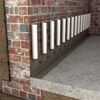Over the past few decades, injection procedures for the subsequent production of horizontal impervious layers in the brickwork have established and proven themselves. These are effective, clean and, in particular, inexpensive procedures. The latest development in this field is the revolutionary cream technology.
Kiesol C - Cream technology as a problem-solver
During the development phase, it became clear that a concentrated cream formulation could overcome many problems of traditional horizontal seals.
The application benefits are evident. Compression makes little sense when using a cream-like material, because the consistency has no advantage here and/or could even collapse in an application of this kind. Therefore, cream-like material is predestined for a pressure-free application. With respect to processing, the consistency has the advantage that the material does not run out of a horizontal borehole. Complex slanted drilling, that always involves drilling through the masonry brick, is not necessary; instead, it is also possible to drill a horizontal, i.e very short borehole comfortably in the joint especially when there are continuous horizontal joints.
Minimum effort and maximum performance
When comparing the properties of today's injection methods for the production of a horizontal seal and/or the available product systems, Kiesol C has extensive advantages over liquid product systems compared to other cream-like products on the market.
- Kiesol C is WTA tested and certified for pressure-free injection up to a degree of moisture saturation of 95%. The test report is available online.
- The previously required preliminary examinations required to select the liquid injection substances are no longer necessary because Kiesol C can be used at any degree of moisture saturation.
- The drilling effort and the material input, and required time are minimised thanks to the horizontal, streamlined boreholes.
- Due to the streamlined boreholes, subsequent backfilling with borehole suspension is no longer necessary.
1 Drill boreholes
Drill boreholes with a diameter of 12 mm horizontally into the joints ensuring that they are 12 cm apart.
2 Clean the boreholes
Remove the drilling dust from the holes by blowing with oil-free air.
3 Inject the active ingredient
Apply the Kiesol C into the boreholes using a sealant gun and injection lance or corresponding machine technology.
4 Sealing boreholes
After injecting into the boreholes, seal up to the surface with water proofing filler.
5 Supporting measures
Creation of a vertical waterproofing strip in the Kiesol system. At least 30 cm above the borehole level.

Pressure-free brickwork injection
Important parameters for the structural analysis need to be determined for the pressure-free brickwork injection, e.g. the degree of moisture saturation (DFG) and the free pore volume. The determined parameters define the selection of the optimum procedure technology and the correct positioning of the borehole series.
Kiesol is a long-standing specialist for pressure-free injection. Simple capillary saturation of the wall with Kiesol can be used up to a degree of moisture saturation of up to 80%, if the accessible residual pore volume is sufficient. Countless reference objects and numerous test certificates and examination reports verify this impressively. The active ingredient of the product is deposited in the capillary pores of the wall making them narrower. In addition, the walls of the pores are hydrophobized, i.e. made water repelling.
1 Priming
Apply Kiesol (1:1 with water) evenly on the prepared subsurface. Pre-wet heavily absorbent subsurfaces with water.
2 Bonding course
Apply the Kiesol bonding course made of WS Sulfatex with the wide brush within the response time.
3 Equalisation
Equalise all unevenness with waterproofing filler in a wet-on-wet method.
4 Drill boreholes
After plugging the injection area, drill holes into the brickwork max. 12.5 cm apart with a diameter of 30 mm and an inclination of 45°.


Brickwork injection with low pressure
At a pressure of approx. 5 bar, the brickwork is visibly saturated via a packer system. The procedure has the benefit that larger quantities of the active ingredient can be applied quickly, safely and in a controlled manner. Optionally, security can also be increased with a multi-level injection and the use of a wet-on-wet procedure.
Low-pressure procedure
The low pressure method offers an essential advantage - the controlled and fast
saturation of the brickwork and the fact that it can be applied even at high degrees of moisture saturation of more than 80 %.
Wet-on-wet procedure
In the wet-on-wet procedure, hollow spaces are filled and the injection agent is applied into the brickwork via the same boreholes, i.e. without time-consuming redrilling.
Kiesol application
- Brickwork injection against rising capillary damp in a pressure-free procedure up to 80% DFG and in the low-pressure procedure up to 95% DFG
- Surface hardening and improvement of the chemical resistance due to silicification
Kiesol iK application
- Brickwork injection against rising capillary damp in a pressure-free procedure up to 95% DFG and in the pressureless procedure up to 65% DFG
- Wet-on-wet procedure (multi-level injection) in conjunction with borehole suspension
Borehole suspension application
- Repair of hollow-space and loose brickwork acc. to WTA information sheet 4-3-98/D.
- Filling of joints, in particular when stones need to be exchanged
Sealing to prevent rising damp
2 products foundView:
Article No. 072755
Silane cream for horizontal barriers against rising damp in masonry


![Kiesol C [basic] Kiesol C [basic]](https://m.remmers.com/gebindeabbildungen/2400w/39697.png?version=0&w=100)